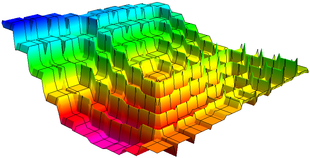10-327/Homework Assignment 5: Difference between revisions
(EDIT: moved Kai's HW5 solutions to new page) |
|||
| (2 intermediate revisions by one other user not shown) | |||
| Line 13: | Line 13: | ||
*Question. In 4. By bounded metric space you mean there exists a point and an epsilon where this epsilon nbd contains everything in the metric space? -Kai |
*Question. In 4. By bounded metric space you mean there exists a point and an epsilon where this epsilon nbd contains everything in the metric space? -Kai |
||
** Indeed so, though usually when talking about boundedness, people use the letter <math>M</math> and not the letter <math>\epsilon</math>. It makes no difference, of course. |
** Indeed so, though usually when talking about boundedness, people use the letter <math>M</math> and not the letter <math>\epsilon</math>. It makes no difference, of course. |
||
===Solution=== |
|||
[http://katlas.math.toronto.edu/drorbn/images/7/77/10-327a501.JPG page1] |
|||
[http://katlas.math.toronto.edu/drorbn/images/7/7e/10-327a502.JPG page2] |
|||
[http://katlas.math.toronto.edu/drorbn/images/6/6b/10-327a503.JPG page3] |
|||
[http://katlas.math.toronto.edu/drorbn/images/6/61/10-327a504.JPG page4] |
|||
[http://katlas.math.toronto.edu/drorbn/images/1/1d/10-327a505.JPG page5] |
|||
[http://katlas.math.toronto.edu/drorbn/images/c/c6/10-327a506.JPG page6] |
|||
[http://katlas.math.toronto.edu/drorbn/images/7/77/10-327a507.JPG page7] |
|||
[http://katlas.math.toronto.edu/drorbn/images/d/df/10-327a508.JPG page8] |
|||
[http://katlas.math.toronto.edu/drorbn/images/9/9d/10-327a509.JPG page9] |
|||
[http://katlas.math.toronto.edu/drorbn/images/8/8e/10-327a510.JPG page10] |
|||
[http://katlas.math.toronto.edu/drorbn/images/7/75/10-327a511.JPG page11] |
|||
[http://katlas.math.toronto.edu/drorbn/images/7/70/10-327a512.JPG page12] |
|||
[http://katlas.math.toronto.edu/drorbn/images/d/dc/10-327a513.JPG page13] |
|||
[http://katlas.math.toronto.edu/drorbn/images/4/4d/10-327a514.JPG page14] |
|||
[http://katlas.math.toronto.edu/drorbn/images/c/c5/10-327a515.JPG page15] |
|||
[http://katlas.math.toronto.edu/drorbn/images/6/6d/10-327a516.JPG page16] |
|||
[http://katlas.math.toronto.edu/drorbn/images/c/c6/10-327a517.JPG page17] |
|||
[http://katlas.math.toronto.edu/drorbn/images/d/d5/10-327a518.JPG page18] |
|||
An assignment without a solution is like a nightmare to me. I like every question accompanied |
|||
with a clean solution beside.(Might not be the case for research question because they are just |
|||
simply too hard.) I would like to share this happiness of understanding and acquiring knowledge |
|||
with everybody because I don't think this class is a battle. I certainly don't like the idea that |
|||
we should keep information/answers as something like business secrets. This learning process |
|||
should be enjoyable which should be full of discussions instead of things like "you have to think on |
|||
your own/ I can't tell you the answer". I know maybe other people might not agree with me but I believe |
|||
a positive learning environment is crucial to truly learn something well although we should not neglect |
|||
independent thinking. That is why I share whatever I have with you. If I am wrong feel free to criticize |
|||
me, and I am pretty sure a lot of people don't agree with me. But that is OK because there is just no |
|||
absolute right or wrong and everybody is doing what they think is right. Just like you can't say if |
|||
Axiom of choice is right or not. If you believe then it is right. If you don't believe it then it is wrong. |
|||
Or maybe, for the entire subject--math, if you believe it then it is right. If you don't believe it then it |
|||
is completely wrong.-Kai |
|||
Latest revision as of 21:54, 10 December 2010
| ||||||||||||||||||||||||||||||||||||||||||||||||||||||||||||
Reading
Read sections 26 and 27 in Munkres' textbook (Topology, 2nd edition). Remember that reading math isn't like reading a novel! If you read a novel and miss a few details most likely you'll still understand the novel. But if you miss a few details in a math text, often you'll miss everything that follows. So reading math takes reading and rereading and rerereading and a lot of thought about what you've read. Also, preread sections 28 and 29, just to get a feel for the future.
Doing
Solve the following problems from Munkres' book, though submit only the underlined ones: Problems 1, 4, 5, 6, 7, 8, 9, 12 on pages 170-172, and problem 2 on page 177. (For the last, recall that ).
Due date
This assignment is due at the end of class on Thursday, November 11, 2010.
| Dror's notes above / Student's notes below |
- Question. In 4. By bounded metric space you mean there exists a point and an epsilon where this epsilon nbd contains everything in the metric space? -Kai
- Indeed so, though usually when talking about boundedness, people use the letter and not the letter . It makes no difference, of course.

![{\displaystyle [0,1]}](https://wikimedia.org/api/rest_v1/media/math/render/svg/738f7d23bb2d9642bab520020873cccbef49768d)






